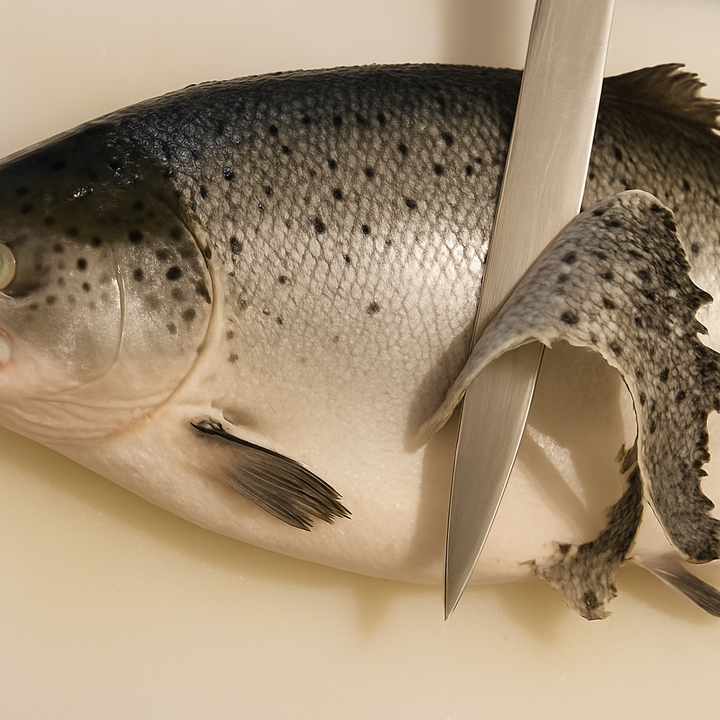Master Sashimi Cutting: Essential Guide to Hira-zukuri and Sogi-zukuri Techniques
Discover why elite sushi chefs spend years perfecting hira-zukuri and sogi-zukuri cuts. Learn the ancient techniques that transform thousand-dollar fish into transcendent dining experiences

When you're enjoying a plate of wild bluefin tuna sashimi at a high-end restaurant, you might assume the premium price comes purely from the rarity of the fish.
While that's certainly part of the story, there's another factor that separates extraordinary sashimi from merely expensive raw fish: the way it's cut.
In Japan's most exclusive sushi bars, master chefs treat their knives with the same reverence a violinist shows their Stradivarius.
They understand that transforming a piece of premium fish into transcendent sashimi requires techniques refined over centuries.
Today, we're pulling back the curtain on two cutting methods that define luxury sashimi preparation: hira-zukuri and sogi-zukuri.
Why Your Luxury Dinner Depends on a Single Knife Stroke
Here's something most diners never realize: the moment a knife touches that pristine piece of wild Japanese sea bream or fatty yellowtail, it either preserves or destroys what makes the fish special.
Think of it like this—imagine spending thousands on a rare wine, then serving it in a plastic cup. The vessel matters, and in sashimi, the "vessel" is the cut itself.
When a blade passes through fish flesh, it's either maintaining the delicate cellular structure that holds oils, moisture, and flavor, or it's crushing those cells and letting everything that makes the fish extraordinary leak away.
A properly cut piece of premium otoro tuna melts on your tongue because the cells remain intact until the moment they meet your palate.
A poorly cut piece, even from the same fish worth thousands, tastes flat and lifeless because those cells were damaged during cutting.
The difference comes down to technique, and in the world of high-end sashimi, two methods reign supreme.
Hira-zukuri: The Foundation
Hira-zukuri sounds deceptively simple. It's a straight cut that produces rectangular slices about one centimeter thick.
If you've ever eaten sashimi, you've probably had fish cut this way. But here's where things get interesting—executing this "simple" cut properly takes years of practice.
Picture a chef at work. They're using a yanagiba, a chef knife that might cost more than your mortgage payment, with a blade so sharp it could split a falling hair.
The chef positions the knife perpendicular to the fish's grain, then draws the blade through in one fluid motion, using every inch from heel to tip. No sawing, no hesitation, just one perfect stroke.
This technique works brilliantly for showcasing premium ingredients because it reveals exactly what you're paying for.
When you order wild-caught kinmedai or golden eye snapper at a luxury establishment, hira-zukuri lets you see the intricate marbling, the way fat weaves through the flesh like veins of precious metal through ore.
Each slice maintains uniform thickness, ensuring that every bite delivers the same perfect balance of texture and flavor.
Master chefs adjust their approach based on what they're cutting. Fatty hamachi belly gets slightly thicker slices to prevent the delicate flesh from falling apart.
Lean wild hirame receives thinner cuts to concentrate its subtle flavors. It's this kind of intuitive adjustment that separates great chefs from merely good ones.
Sogi-zukuri: The Advanced Technique
While hira-zukuri forms the backbone of sashimi preparation, sogi-zukuri represents the technique that makes food critics reach for their superlatives.
This angled cutting method creates diamond-shaped slices that are thin at one edge and thicker at the other.
To execute sogi-zukuri, the chef holds their knife at a precise angle—usually between 30 and 45 degrees—to the cutting board.
As the blade slides through the fish, it creates slices with varying thickness that serve multiple purposes.
The thin edge allows soy sauce to cling better, the thicker portion provides satisfying texture, and the overall shape creates stunning visual presentations that justify those premium prices.
This technique particularly shines with firm, white-fleshed fish like wild Japanese flounder or premium Mediterranean sea bass.
The increased surface area intensifies delicate flavors that might get lost in thicker cuts.
When applied to exceptional specimens like wild-caught suzuki, skilled chefs can create slices so thin they're translucent, allowing diners to literally see the quality of what they're about to eat.
Tools That Cost More Than Cars (And Why They're Worth It)
Let's talk about equipment for a moment, because in the world of luxury sashimi, the tools matter as much as the technique.
The yanagiba knife isn't just sharp—it's a marvel of engineering developed over centuries specifically for this purpose.
These knives feature a single-beveled edge, meaning they're sharpened on only one side.
This design minimizes friction as the blade moves through fish, preventing the kind of cellular damage that ruins premium ingredients.
The best examples, hand-forged by legendary craftsmen using traditional methods, can cost thousands of dollars. Sushi masters often own multiple yanagiba knives, each optimized for different types of fish.
The cutting board matters too. Traditional boards made from Japanese hinoki cypress provide the perfect balance of grip and give, protecting both the knife's edge and the fish.
These boards, which can run several hundred dollars, require careful maintenance but contribute to the precision that luxury sashimi demands.
The Years-Long Journey to Mastery
Traditional Japanese sushi apprenticeships might shock Western sensibilities—students often spend their first year simply observing, watching masters handle fish, maintain knives, and judge quality before ever touching a blade themselves.
This patient approach makes perfect sense when a single misguided cut could waste hundreds of dollars of bluefin tuna or, worse, disappoint a customer expecting transcendence.
Today's top Western chefs increasingly recognize this wisdom, traveling to Japan to study techniques that no amount of molecular gastronomy can replace.
They understand that in the world of luxury sashimi, foundational knife skills remain irreplaceable.
The Bottom Line: Tradition Still Defines Luxury
Despite sous vide machines and liquid nitrogen becoming kitchen staples, the finest sashimi still relies on techniques perfected centuries ago.
Hira-zukuri and sogi-zukuri achieved their pinnacle through generations of refinement, not innovation.
Whether you're dining at Tokyo's three-Michelin-star temples or Manhattan's newest luxury venues, the difference is unmistakable—each slice embodies a philosophy that honors both ingredient and diner, transforming raw fish into an experience that justifies every dollar spent.
In our tech-driven world, these ancient techniques remain the undisputed gold standard.


